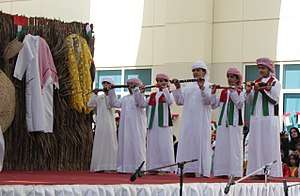Yowla
Yowla (Arabic: اليولة / ALA-LC: al-yawlah) or Al Yowla[1] is a traditional weapon dance in the United Arab Emirates.[2] It's a victory dance common during celebrations, weddings, and events.[1] It is also referred to in the press as the Yola[3] or Yollah dance.[4]. The Yowla is originally a Bedouin dance routine, which involves men spinning rifles as a victory dance after victory in a battle.[3]

The dance
The dance involves boys and men spinning swords to traditional Emirati music.[5] The performance also can involve spinning and throwing a dummy rifle[6] made entirely of wood and metal plating. Men dance to the rhythm and music by moving in an up and down step while constantly spinning, throwing and performing several tricks with the rifle. This type of dance requires great skill and concentration.
In popular media and politics
The Dubai Department of Tourism and Commerce Marketing since 2002 has organized the Shaikh Hamdan bin Mohammed bin Rashid Al Maktoum Championship, which includes the Al Yowla Championship.[7]
According to the Guinness World Records, the largest Yowla dance took place in Fujairah on November 26, 2010, with 285 participants from three different tribes taking part in a traditional sword competition performed for the Crown Prince of Fujairah.[8]
In 2017, a jail threat was issued by the UAE over a viral dance video meme featuring young people performing yowla.[6] The videos, also filmed in cars and on roads, were set to "Mutsawe" by singer Eida Al Menhali.[3] The Sheikhdom’s Attorney General Hamas Saif Al Shamsi said the videos of the dance were "damaging to Emirati society."[6]
See also
References
- "Qasr Al Hosn festival 2014". TimeOut. Retrieved 23 May 2019.
- Al-yowla contest today, Khaleej Times, 4 February 2004
- "Authorities and parents warn young Emiratis over 'offensive' viral dance craze". The National. Retrieved 23 May 2019.
- "Why dance traditions mean a lot to Emiratis". The National. Retrieved 23 May 2019.
- "Global Village: Where food, fun, fashion and the fabulous meet". Gulf News. Retrieved 22 May 2019.
- "UAE issues Jail Threat After 'Weird' Dance Video Goes Viral". Newsweek. Retrieved 23 May 2019.
- "DTCM lines up skill contests for DSF". Khaleej Times. Retrieved 23 May 2019.
- "Largest yowla dance". Guinness World Records. Retrieved 23 May 2019.